Published 21 October 2018 ● Last Updated on 16 September 2020
This article comes from the heart of our guest author, Akshata Rao, who is a self-confessed ‘mountain girl’. She recently collaborated with Secondsguru and helpd us put together the 2018 version of our 10 favorite vegetarian restaurants in Singapore [Full article here]. Akshata is an engineer by day who moved to Singapore about a year back, her sixth home in a decade. When her itchy feet aren’t taking her all around town to events, restaurants or window-shopping, she’s finding the next change she can make to live a greener, cleaner life. Find her trysts with Singapore on Instagram and her blog.
I’m a mountain girl at heart. I’ve also come to appreciate sparkling blue waters and clear skies in the one year that I’ve lived in this pretty island of Singapore, but every so often my heart yearns for sweeping vistas from high above and cold wind in my hair. This wanderlust has taken my itchy feet twice into the Himalayas on week-long treks, and these have been turning points in my journey towards a greener lifestyle. How did a trek turn into inspiration for green living, you ask? Read on.
Indiahikes, the organization we chose for our forays into the world’s highest mountains, has grown to be India’s largest trekking organization in the last decade. Cognizant of the large number of trekkers they were leading up into the Himalayas, Indiahikes started their Green Trails to work towards making an effort to leave the high altitudes greener than we find them. Today, the Green Trails effort reaches far beyond just leaving the mountains clean. The waste collected from the slopes are brought back to villages at the base camp where they are segregated and either sent to the cities below or upcycled into products by the village women. Green Trails also conducts awareness sessions in schools and communities to engage villagers and open their eyes to the importance of waste management at altitude. Headed by Dr.Lakshmi Selvakumaran, the GreenTrails team is constantly innovating how to leave nothing but footprints behind on the mountains.
Indiahikes’s trekkers play a big role in this process, and today I’d like to share with you what I’ve learnt from them – why we need to take care of our high mountains and a few tips to be a green trekker.
Why is it important to be greener than usual at high altitudes?
- Little villages on the slopes of mountains are clusters of barely a few households with no city councils to regularly clear waste. The villagers take it upon themselves to collect the trash and burn it without segregation or any safety measures.
- Whatever is not burnt is left to decompose. At high altitudes, this takes much longer because of low temperatures and lack of sunlight which inhibit microbial growth that aid decomposition.
- Plastic dries out the soil by preventing water absorption and this leads to easy erosion, steadily reducing the plant life that can be supported. That we know is a vicious cycle.
- A lot of trash makes its way into the high reaches of water sources, which is the primary source of water for these villagers. Their health is endangered by this increasing pollution, and when this water reaches the cities, so is ours.

The need for being green established, here are my 7 TIPS on How to Be A Green Trekker
#1 Food and Packaged Snacks
Let’s face it, you’ve been walking all morning through rain and wind and you’re quite ready for lunch. You suddenly see a little dhabha (local village eatery) that caters to trekkers on this route. The thought of a hot bowl of Maggi (noodle soup) has kept you going this far. But pause a moment there and spare a thought to the carbon footprint of consuming packaged food at high altitude. One, transport vehicles travel several hours to get to these high reaches to bring in supplies. Two, soft plastic packaging takes hundreds of years to degrade if you leave it up here in the mountains. The local eateries stock these only because there is a high demand for them. What if we trekkers opened our eyes instead to the many local delicacies these places can serve us? In the Himalayan villages, you can look to partake the local noodle soup thukpa and the immensely satisfying momos. Local greens and cheeses only have to travel up from the foothills, and they are natural sources of carbohydrates, fats, and proteins. Why reach for a packet when nature serves you fuel and recovery options on a green platter?!
Here is a note by Dr.Selvakumaran about a list of local delicacies in the Sandakphu range of the Himalayas-if you are headed there sometime soon- to give you an idea of your choices there. If you are headed someplace else, do a spot of research into the local cuisines in the regions you are visiting, and chat with the eatery owners politely if they can serve those to you. When it comes to snacks, prepare trail mixes and energy bars at home and carry them with you. When the demand for packaged snacks reduce, so will the carbon impact of the supply and the soft plastic waste left behind. Natural nutrition is good for both us and the high mountains!
What Indiahikes does on the Green Trails? Indiahikes hires a team of cooks from the local communities near each trek route who accompany a 25-member trek group and serve freshly cooked food everyday. The thought and planning that goes into each day’s menu is similar to a sports nutritionist helping you to ace a race, taking into account altitude and activities for the day. Every single meal I’ve eaten on the treks has been regenerative for both body and soul. Imagine huddling in a large dining tent with your fellow-trekkers as a storm rages outside, sipping on hot milk tea and digging into fresh fried bread after a long day out in the cold, not a single sound of crinkly packaged plastic to interrupt this magic on the mountains!
# 2 Reusable Cutlery
So once you have your food sources figured out, how about looking into what do you eat them on/with? If you’re camping overnight, it is only natural to bring your own cutlery. But don’t be afraid to whisk it out at local eateries as well if you see them leaning towards paper or plastic. There is almost always a water source nearby, however basic, and washing these out will not be a problem.
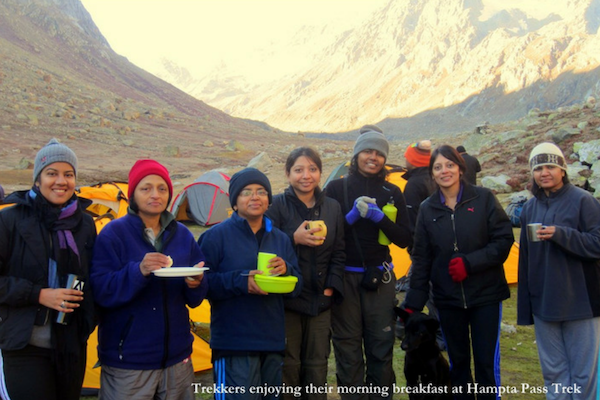
What Indiahikes does on the Green Trails? Each trekker is required to bring their own cutlery on the trek – a box, spoon and mug. I filled the box with lunch handed out every morning before we set out and rinsed it to eat dinner from at night. The mug held my morning coffee at a spectacular sunrise, refreshing lemon tea as I reached camp exhausted every evening, and hot soup to feed my soul at snack time.
# 3 Wet Wipes
Bathing on a weeklong trek is possible only if you’re brave enough to jump into ice-cold alpine lakes or if you find a stream near camp which doesn’t feed into your water source. Both aren’t for everyone, and we automatically reach for the catch-all solution, the wet wipe. We tend to equate this to “just paper” or “like toilet paper” and don’t think twice about using it to wipe ourselves down or in the loo. Time to stop and pause! A wet wipe is made from non-woven fabric interlinked with plastic, and it contains chemicals that prevent microbial growth. The result – they do not decompose for hundreds of years! Watch a three-minute video with Neha from Indiahikes for a practical lab demo and see for yourself. And no, you did not have to compromise on hygiene at all. Just like Neha suggests, toilet paper with a few drops of water does the trick and feels exactly like a wet wipe. If you’d like something more than water, choose a hand sanitizer with alcohol and avoid triclosan which has been shown to create resistance to antibiotics in humans.
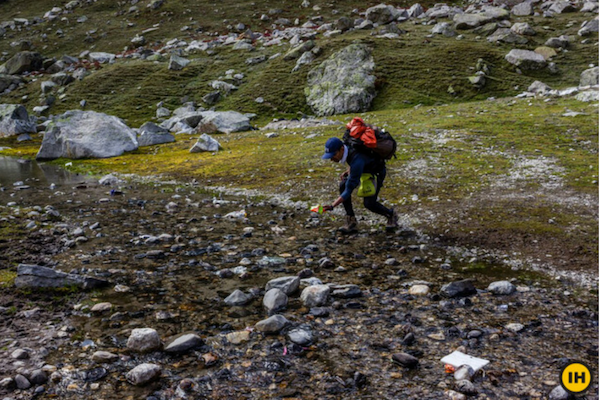
What Indiahikes does on the Green Trails? Each campsite is close to a water source for obvious reasons – we need water to cook and wash up, the two daily essentials. Face and dishwashing are not done directly at the source, but large containers are filled and used at the other end of camp. The toilets though are all dry toilets – deep pits within a toilet tent. No water is allowed here because too much moisture disrupts and extends the decomposition time. Cocopeat (coconut husk powder) or sawdust is used to layer and cover up the toilet when the camp moves, it a natural source of carbon which aids and speeds up decomposition. The end result? Excellent manure for springtime green cover on the mountain slopes!
#4 Cosmetics
When you reach for a simple facewash after a long day outdoors, it feels like the most harmless way to clean up and stay fresh. But if you flip the tube and find microbeads, you can rest assured that what feels good in the moment is just going to stay in the soil forever. Microbeads are tiny pieces of plastic which are added to cosmetics for their exfoliating effect. They are impossibly hard to filter and stay in water systems for hundreds of years, thereby entering food chains and disrupting health. Here is a guide by Secondsguru on how to identify microbeads in your cosmetics, and what you can do to avoid them. You can start by switching to brands that are eco-friendly and suit your taste and budget. Or if you’re feeling adventurous, Indiahikes has a few nifty recipes to make your own green cosmetics and shove them into little airtight tins to carry with you. Stay fresh, stay green!
#5 Sanitary Napkins
Mountain-loving girls, we don’t let our menstrual cycles stall our tango with our mountain highs, do we?! If you’re using a menstrual cup, you’re already as green as you can be here, so hop along to the next point. But if you’re using sanitary pads or tampons, there are two very important reasons not to dispose these at high altitude. One, these products contain a significant amount of plastic which by now we know does not degrade in the mountains. Two, leaving them behind anywhere, either buried in the ground or any village trash can attract wildlife when the trekkers are not around and lead them to ingest it.
So what can you do to be a green trekker in this dicey situation? Well, it requires a bit of a mindset change, but reach out to Indiahikes if you don’t believe me and hear from them how many of their trekkers have done this and faced no problems at all. Trekkers anyway carry tissues and toilet paper. Just wrap up these products tightly in paper, put them in a Ziploc bag, and stash them away in a separate corner of your bag. Bring it down to the cities and then dispose of them as you would other regular trash. Granted, this is not as green as the cup, but at least you are keeping it away from sensitive regions where it can do the most harm.
#6 Take a trash bag!
This happens to be the most important one. The reason I’ve saved the best for last is that this will not only help us stay green, but it will make us more responsible trekkers. It’s along the lines of plogging which Secondsguru has written about here. Take a little bag that you can clip to your waist or backpack and stow all your trash in it (banana peels, nut skins, paper tissues, etc.). And here’s the cool part, also pick up any trash you see on your trail like snack packets and chocolate wrappers which others have left behind. If your camp has a central collection unit, you can empty these out at the end of each day; else you can bring it down to the cities and trash it. This way, you’re not leaving the mountains exactly as you found them, but greener than you found them. And this is a pretty cool way to be a green-er trekker!
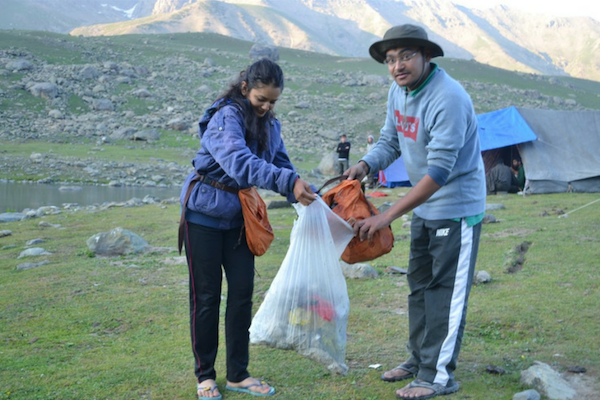
What Indiahikes does on the Green Trails? Each trekker is given a clip-on eco-bag into which they put all their trash and the trash they find on the trail, emptying it out into the campsite collection point each day. This is taken down to base camp at the end of the trek where local labor is employed to segregate the waste. Whatever can be upcycled stays in the village where the local women are paid to make plastic bricks, cushions and other innovative products that the Green Trails team keeps coming up with (Check their online store here for new stock in December). Everything else is sent to the cities to be recycled or trashed. By involving and educating all stakeholders in the waste creation and management chain, this single-minded effort from Green Trails has kept huge amounts of trash from stagnating in the high hills.
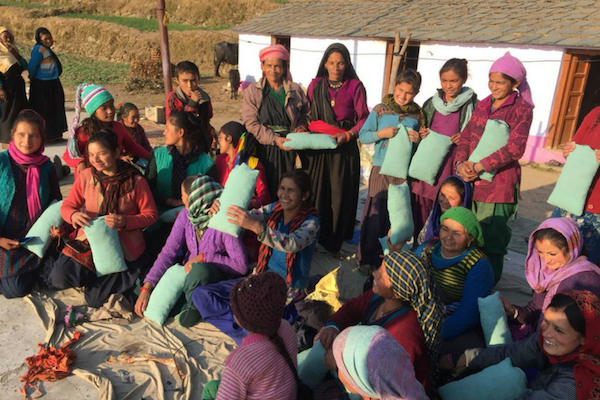
Translating All Of It Into Daily Life
I know, this article is all about being a green trekker, but I just wanted to put it out there that most of these can be implemented in our daily lives too. I started learning about local food on my vacations, taking my own box for tabao orders, and carefully reading the label of the cosmetics I buy. I’m still working on the courage to fully give up wet wipes for house-cleaning and sanitary napkins and I’m surrounded by a very encouraging green community in this journey!
Be A Green Advocate
After trekking with Indiahikes and learning from them, I am more cognizant of the challenges I face if I want to be a green trekker. As I research the organizations that offer climbs up Mt.Kinabalu, Mt.Fansipan and Mt.Fuji for next year, I’m coming up with a list of questions to ask them based on the lessons I learnt above. The more we trekkers request information about a company’s green initiatives, the more they will open their eyes to providing it for us. Don’t be afraid to ask (politely), listen to their point of view, and help them resolve any challenges they have by using the tips above or directing them to world-wide green trekking organizations like Indiahikes for advice. And let us implement whatever is within our personal control so that we can show off the object of our desires – the mountains – to our future generations!
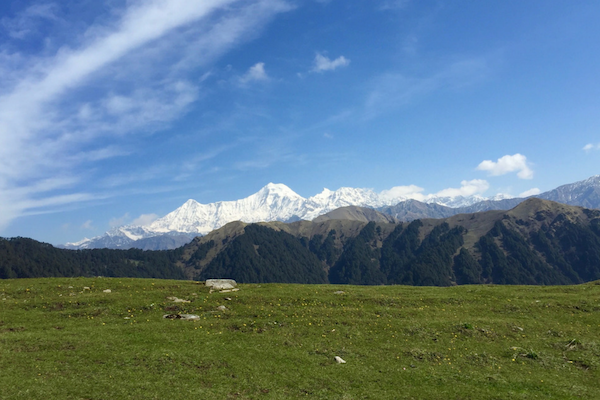
All Green Trails photos reproduced with permission from Indiahikes. Follow them on Facebook, Instagram and Green Trails Instagram.
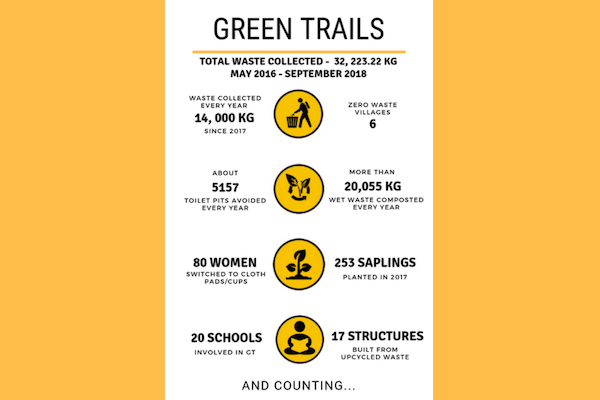
Happy trekking, stay safe and green!



0 Comments